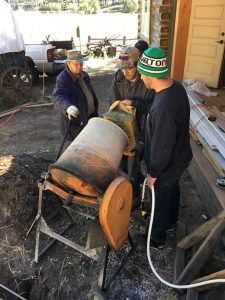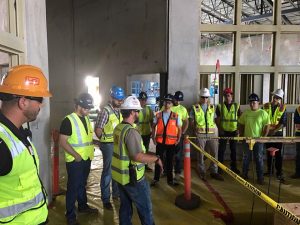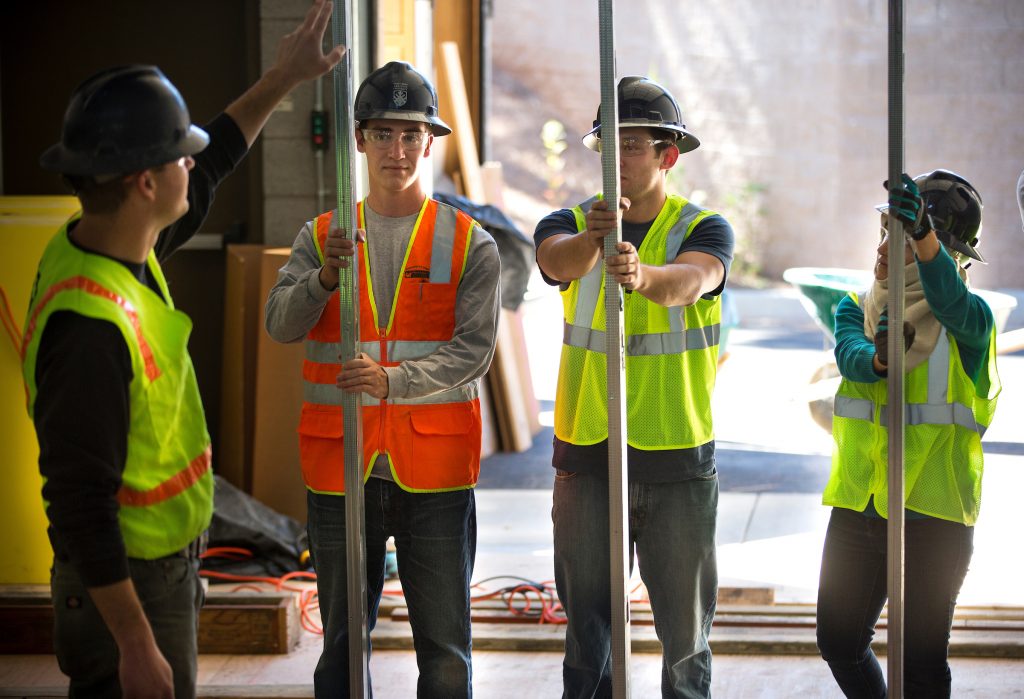Feb. 18, 2019
On graduation day, dozens of seniors from Northern Arizona University cross the stage, shake hands with the president, wave to their families and move their tassel from the right side to the left—of their graduation hard hat.
Then they all go to work.
Construction management is a growing field, and NAU’s program, part of the recently created College of Engineering, Informatics, and Applied Sciences, can’t grow fast enough to keep construction companies in Arizona staffed. In January, associate professor John Tingerthal said a majority of the program’s May 2019 graduates already had jobs. Some had jobs last summer. A few lined up jobs during their junior year.
“Companies are looking for people who can hit the ground running,” Tingerthal said. “Instead of having to train someone for 10, 15, 20 years, they can come in and start off at a higher level and then work into wherever they want to go.”
NAU, which has a nationally recognized program, produces close to 50 graduates a year, but even with the programs at Arizona State and the University of Arizona is not keeping up with the pace of construction in Arizona or nationwide. Diane Stearns, interim dean of CEIAS, said the employers who come to NAU to recruit said Lumberjack grads always come out on top in comparison to other programs.
“I’ve been meeting with employers, donors and alumni, and I’m always asking them, what do you think about our majors? What do you think of our construction management students?” Stearns said. “One, we can’t graduate them fast enough. Two, they like our students because of their hands-on experience and their work ethic.”
Employers who routinely recruit at NAU echoed Stearns and Tingerthal.
“Wilson Electric Services Corp actively recruits graduates from the NAU construction management program because of the cultural alignment of the students, faculty and curriculum with the needs of our industry,” said Todd Klimas, vice president of Wilson Electric. “There is an ideal, supportive atmosphere throughout the program. By graduation, NAU program students have cultivated practical, applicable skills and are immediately employable on construction projects.”
“The NAU construction management program continues to excel and generate top tier students entering today’s competitive workforce,” said Steve Whitworth, president of Phoenix-based Kitchell Contractors. “The students are pushing the construction industry to the next level, providing innovative and thoughtful solutions to the built environment. NAU’s program continues to thrive and we look forward to continuing our long-standing partnership.”

What is construction management?
The field itself is a mix of engineering, business, management, skilled labor and problem-solving. Math and physics are part of the curriculum, similar to engineering programs, but most of the construction management courses focus on how to do the job—methods, materials, design. NAU students also graduate with a minor in business, since they take accounting, finance, marketing and management courses to equip them to write prepare bids and plan multimillion-dollar projects.
While the curriculum does not include a mandatory internship, many students obtain internships in the summers, some as early as after their first year. This allows students to experience a broad swath of the construction industry and companies to see how well students work with their teams. In addition to the experience, many of these internships turn into a job offer.
Graduates typically have the option to select an office track or a field track with their careers. The field track puts managers on the job site, running the day-to-day construction of a project. The office track includes more planning, writing proposals, submitting bids and coordinating with different stakeholders. Both are good career options, Tingerthal said; the right choice for students depends on whether they want to be inside or outside. Both require a fair amount of learning a new language, so to speak.
“I always kid my students: I know you want to build things, but you’re going to spend 90 percent of your time working with people and solving people problems. It’s a people problem-solving industry,” he said. “It’s really because you’re in the middle; you’re speaking four different languages. I look at whatever I teach as learning a language as much as anything.”
The program started as a superintendent training program during a time when many construction bosses started out as tradespeople and rose through the ranks over the years. In the late 1990s, NAU received accreditation through the American Council for Construction Education, and the program transitioned into the professional program that it is today.
Nationally, construction management students tend to gravitate more toward the office side of the industry, Tingerthal said, but at NAU the numbers are split fairly evenly.
Putting their experience to the test
Earlier in February, about 30 students and a few faculty advisers loaded onto a bus and headed to Reno for the Associated Schools of Construction regional competition. Three teams competed in different categories, taking on real-world problems designed by industry sponsors, such as designing a building on environmentally sensitive land or preparing a bid, including timelines, cost estimates, subcontractors and anticipated problems with solutions, for a civil project like a bridge. They work for a full day without access to outside help, including mobile phones or access to the Internet.
Then the team presents their project to a panel of judges, most of it not all of whom are from construction companies. More often than not, Tingerthal said, the panel includes people who actually built the project on which the students work. It’s a grueling process that simulates the stressors of an actual design and build project, and it puts students in front of bosses looking to hire the best.
NAU took second place in the heavy civil division and design build division. The heavy civil team members are Herb Tiffany IV, Cougar Parmiter, Erik

Harding, Brycen Killion, Braeden Miller and Isaiah Bell with alternates Parker Braaten and Joseph Morris. Professor Kai Kaoni coached the team with support from Granite Construction. The design build team members are Makenna Vis, Daniel Marquez, Patrick Esmurdoc, Matthew Saunders, John Amorosi and Steven Contreras, with Jessica Roth and Alec Latino as alternates. Professors Agnes Drogi and Alan Francis coached the design build team with support from Wilson Electric, Wespac and Ryan Construction. The commercial team, comprised of Mike Headley, Bryan Looney, Zach Patrick, Max Williams, Matt Warner, Paxton Travale and alternates Rees Bixler and Tyler Coffey, was coached by professor Rob Bruner and supported by Kitchell contractors. Although they didn’t place this year, NAU has placed first or second four of the last six years in this competition.
Tiffany, the captain of the heavy civil team, said hearing their name called was a bittersweet moment. Five of the six team members were new to the competition and they showed up prepared for the challenge and he was proud. On the other hand, they were gunning for first.
The assignment, which went from 6 a.m. to 10 p.m.—a day in which they needed every single moment—was estimating total costs for a utility project, to which a company would devote four to eight weeks. They created a detailed task schedule, did an in-depth quantity takeoff for all the items, assessed the project’s risks and ways to mitigate those risks and prepared a presentation. During the day, they were constantly getting project updates, requiring them to shift their work. The 10 p.m. deadline was hard and fast. At 10:01, they would have been disqualified.
“Our team did all this to obtain a final bid proposal, which we hand-delivered to the problem sponsor at 9:55 p.m.,” he said. “We had to make sure our deliverables were better than any of the other 14 teams in the competition. This means that our work had to be top notch and go beyond what is expected so that we could stand out to the judges.”
Tiffany, who graduates in May, will go to work for Granite Construction in Tucson, which is also one of the program sponsors. Generous support from Kitchell Contractors, Wilson Electric, McCarthy Builders and Sundt Construction also helped the teams prepare and compete.

Hands-on learning
The program also includes a series of three one-credit classes called C4P, short for Construct for Practice, an experience students in most other construction management programs don’t have. Students take this course three times through the course of their education. As sophomores, they build an 8-foot by 8-foot mockup of a building.
“It includes all the systems you might have in a building—they pour a little concrete, put up stud walls, put up drywall, do a little plumbing and a little electrical,” Tingerthal said.
As the sophomores build, the juniors design. They act as architects, creating the design, specifications and drawings on which the sophomores rely to build. There are always a few errors, Tingerthal said, or details that aren’t clear on the plans and require communication between the two groups. That’s also a normal part of construction.
Finally, the seniors are the project managers who train the young students on safety procedures, how to use tools, selecting appropriate materials and how to communicate. After their third year, students have experience in all aspects of building, from being a tradesperson all the way up to being a project manager. They know the language, they know potential pitfalls and they know how to resolve issues.
“They’re going to be managing people, and there could be a sense of, ‘I’m a college graduate, I know it all, these are just tradespeople,’” Tingerthal said. “When they have to lay out bricks and they realize just how difficult it is to do a good job, they respect what the craftspeople have to do and what it’s like to be in those other shoes. That’s the best way to manage—to be understanding of what the people you’re working with are actually doing.
“It introduces them to things in context.”
[accordion]
Hear from alumni
Every Thursday, NAU invites representatives from a different construction company to talk about their projects and the industry and also get to know students and do recruiting. Sometimes, those recruiters are NAU alumni. In February, Dan Brown, (’05) and Chris Fletcher (’04), who both work for McCarthy, came to talk Lumberjack to Lumberjack.
Brown, a project director in Tennessee, said he’s been coming back to NAU for 12 years to do these talks and recruit students for internships and jobs—the same way he started with McCarthy.
“We prefer this one for its practical application,” he said, referencing NAU’s hands-on classes, connections with industry and supportive professors. “They’re getting a very well-rounded experience.”
He referenced the C4P labs, the ACS competition and other opportunities for outside development, not only in gaining experience but also in building relationships with industry leaders, as well as events like the construction industry seminars to help him gain a better understanding of the industry. These extras on top of a strong curriculum help students to know what they want to do and be prepared to do it right away, he said.
“This is the reason we keep coming back,” Brown said. “It’s a great program and a high priority for us.”
Fletcher, who works in Las Vegas, said he comes to recruit every semester. NAU students have a solid foundation to move into commercial based, bigger markets, so companies—his own, the competitors he talks to, the companies his team contracts with on projects—all look to NAU. McCarthy has 23 NAU alumni on its teams.
“The program is still strong, and there’s a lot of good talent,” he said. “As far as the market goes, we know NAU has a good pool.”
It’s a smaller program than some, which helps to create relationships between students and professors, which in turn helps build relationships among the construction industry, which he said is a critical part of his work.
[/accordion]

(928) 523-5556 | heidi.toth@nau.edu



